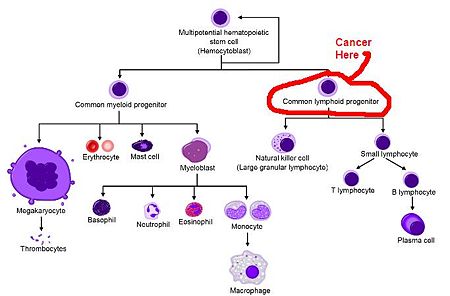Acute lymphoblastic leukaemia
Definition
Cancer of the lymphoblasts (immature lymphocytes)
Epidemiology
Affects 25-45 million children a year with a peak around 4-5 years old. The incidence of childhood leukaemia has increased slightly of the last 20 years. Nobody is sure what this is down to but my personal theory is that aliens are slowly trying to give us cancer so they can take over in War Of The Worlds-style. With all the malaise and lethargy, we won't be able to fight them off.
Pathophysiology
Cancer is basically uncontrolled proliferation of cells. In ALL, this is uncontrolled proliferation of lymphoblasts which are cells that normally go on to form lymphocytes. They crowd out other bone marrow cells and metastasise. How the DNA gets damaged is unclear, gene damage being a prerequisite of cancer.
Risk Factors
- Caucasian children are at higher risk than African-Carribean.
- Infection from the influenza virus
- Down's syndrome
- A bunch of other random stuff (ionising radiation and some chemicals) which probably increase the risk of all cancers.(Carcinogens)
Clinical Features
The following are the common features of leukaemia:
- recurrent infections
- malaise
- pallor (due to anaemia)
- abnormal bruising (including epistaxis and bleeding gums)
- hepatosplenomegaly
- lymphadenopathy
- bone pain
There are a whole list of other features as well. These include failure to thrive constipation, nausea, vomiting and headache. As you can see these are fairly non-specific.
Investigations
The most important test to do is a full blood count. You will see raised WCC and all the other numbers will be low (which includes thrombocytopenia). Presence of blast cells (the lymphoblast from the pathophysiology section on a blood smear is highly indicative of leukaemia but absence does not rule it out.
Anaemia accompanied by low reticulocyte count (reticulocytopenia) is also indicative of leukaemia. Raised MCV, low platelets, low leucocytes (leucopenia) with anaemia are all also indicative of leukaemia.
Bone Marrow Biopsy is the definitive diagnostic screen.
Secondary care
Here further investigations will be done including a marrow aspiration and biopsy, imaging and morphoimmunocytogenic analyses of cells (clever stuff the haematologists to do figure out how to stage the cancer). A lumbar puncture may be performed if infiltration of the brain is suspected.
Management
Chemo. I'll a bit more later.
